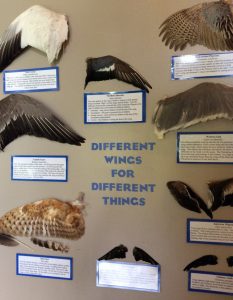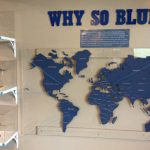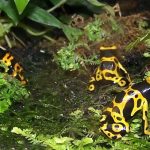We sent some of our specimens on a summer retreat, so that you can enjoy them. Bats, birds and their sounds are on display at the Adventures in Flight Exhibit at three parks in Delaware county: Deer Haven Park, Shale Hollow Park, and Gallant Farm
Each park’s exhibit has a different focus, at Deer Haven park birds rule – not only inside the nature center but also at the feeders outside. I did see a racoon sneak by though during my visit, but that’s a different story.
When you walk into the nature center, a friendly volunteer greets all visitors, explains that following last year’s Ice Age and dinosaur-era exhibit, this year’s exhibit showcases the only non-extinct dinosaurs, birds.
The first display highlights blue birds from all over our Blue Planet. A hummingbird from Brazil, a jay from Mexico and an Indigo Bunting from the USA. The oh so blue Cerulean Warbler greets people at the entrance desk.

Further you will find differently shaped bird wings which allow speedy flight in some and gliding in others.
 The sound kiosk with various drumming patterns of woodpeckers and a snippet from BirdNote, a nonprofit radio program dedicated to the conservation of birds and their habitats, is tucked in the corner right next to the “window on nature” with great looks at various bird species visiting the numerous feeders. A Ruby-throated Hummingbird landed during my visit and drank leisurely from the provided sugar water solution.
The sound kiosk with various drumming patterns of woodpeckers and a snippet from BirdNote, a nonprofit radio program dedicated to the conservation of birds and their habitats, is tucked in the corner right next to the “window on nature” with great looks at various bird species visiting the numerous feeders. A Ruby-throated Hummingbird landed during my visit and drank leisurely from the provided sugar water solution.
In the neighboring room, bird skulls illustrate and highlight the enormous variability in size and shape among birds. Compare a hummingbird skull to a Bald Eagle!
On to the next park:
Shale Hollow park is only a short drive south from Deer Haven, you actually pass it on your way back to Columbus.
The exhibit is well worth a stop: Enter a darkened room to learn about bats, fireflies and moths! Insects and bats are the theme here, including butterflies (a tent with life butterflies is soon to open!).
 A poster gives basic information about the anatomy of flight and why some animals fly and we do not – at least not using our arms as wings, we built machines to take us into the air. To explore man-made flight visit the third of the exhibits at Gallant Farm.
A poster gives basic information about the anatomy of flight and why some animals fly and we do not – at least not using our arms as wings, we built machines to take us into the air. To explore man-made flight visit the third of the exhibits at Gallant Farm.
Can you guess what’s inside this flower?
On my way out I discovered a microscope for smartphones – obviously I still have to practice perfecting my images, but you can guess the intricate patterns of this dragonfly’s wing.
I really enjoyed the exhibits which also showcase specimens from the Natural History Museum at Ohio Wesleyan University. Thank you Liz Neroni for working with us on these displays and letting some of our specimens be part of this exciting summer exhibit – and of course there are plenty of opportunities to enjoy the outdoors while you visit each of these exhibit sites. Enjoy!
 About the Author: Angelika Nelson on her last assignment as the social media outreach manager for the Museum of Biological Diversity.
About the Author: Angelika Nelson on her last assignment as the social media outreach manager for the Museum of Biological Diversity.
7/17/2023: Post edited. Broken link removed.

































































